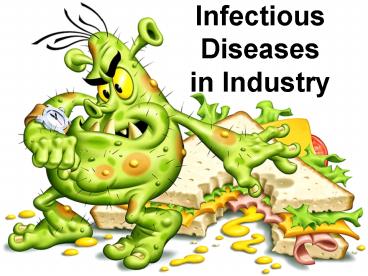Infectious Diseases in Industry - PowerPoint PPT Presentation
Title:
Infectious Diseases in Industry
Description:
The shift to a low fat diet was one of the most dangerous conceptual shifts in public health in ... Influenza is leading infectious disease killer in the US ... – PowerPoint PPT presentation
Number of Views:185
Avg rating:3.0/5.0
Title: Infectious Diseases in Industry
1
Infectious Diseases in Industry
2
Nancy V. Rodway MD MS MPHMedical Director,
Occupational Services, Ambulatory Centers and
Employee Health, Lake HealthMedical Director
Lake County General Health District
3
Objectives
- Highlight select common communicable diseases in
the workplace - Describe the risk of contagion of those diseases
and the route of spread - Consider methods to limit risk of transmission
of those disease - Add a few surprises
4
Influenza
- Influenza is leading infectious disease killer in
the US with 35-40,000 deaths per year
5
Influenza
- Flu is NOT vomiting and diarrhea!
6
(No Transcript)
7
Influenza
- Contagious for 1 day prior to symptoms and up to
5 days after illness begins - Spread by respiratory droplets and direct contact
- Prevent by cleaning surfaces and 5 foot distance
- Anti-influenza medications can prevent onset of
illness after exposure
8
(No Transcript)
9
Vaccination
- Reduces the risk of infection and symptoms
- Reduces the risk of spreading the flu
- Reduces the risk of dangerous complications of
influenza - Influenza vaccination of healthy working adults
saves 47 per person annually in health care
costs and sick days
10
YOU CANNOT GET FLU FROM THE FLU SHOT!!
11
Complications
12
Ringworm
- Tinia corporis
- Tinea pedis
- Tinia capitus
13
(No Transcript)
14
(No Transcript)
15
(No Transcript)
16
(No Transcript)
17
Ringworm
- Acquired by direct or indirect contact with
lesions or pets - Contagious as long as lesions are present
- Not contagious 24 hours after treatment
18
Staphylococcal staph skin infections
- Lets start with the easy one
19
Impetigo
Cellulitis
20
(No Transcript)
21
MRSA
- Methicillin-resistant
- Staphylococcus Aureus
22
MRSA was first isolated in the US in 1968. By
2003, it accounted for 60 of all staph isolates
in ICUs
23
Looks like a spider bite
24
(No Transcript)
25
(No Transcript)
26
(No Transcript)
27
(No Transcript)
28
MRSA
- Does not respond to usual antibiotics previously
used to treat staphylococcus - Certain antibiotics continue to be effective
- Spread by direct contact
- Contagious until 24 hours after treatment
started. - Pus is contagiouskeep covered until lesions dry
29
(No Transcript)
30
Conjunctivitis
- Pink-eye
31
Conjunctivitis
- Highly contagiousup to 75 of those exposed will
get it - Acquired through direct and indirect contact
- Treatment
- Contagious until 24 hours after treatment starts
32
Varicella
33
(No Transcript)
34
(No Transcript)
35
Chicken Pox and Shingles
- Acquired through direct and indirect contact and
respiratory droplets - Contagious 1-2 days prior to rash then 6 days
after rash or until lesions crusted - Keep shingles rash covered in workplace to
prevent transmission - Consider varicella vaccine
36
(No Transcript)
37
Strep Throat
- Tis the season . . . . .
38
(No Transcript)
39
Strep Pharyngitis
- Need to treat with antibiotics to prevent
Rheumatic Fever - Acquired through direct contact with snot
- 25 contagious at most
- Contagious until 24 hours after antibiotics
started
40
Rheumatic Fever
41
The Common Cold
42
Common Cold
- Sore throat, runny nose, sneezing
- Acquired through direct and indirect contact
(dirty tissues) and inhalation of respiratory
droplets (Remember 5 ft!) - Contagious for 24 hours before symptoms appear to
5 days after onset - No need for isolation
43
Poison Ivy
44
NOT CONTAGIOUS!
45
(No Transcript)
46
(No Transcript)
47
(No Transcript)
48
Krokodil
49
(No Transcript)
50
(No Transcript)
51
Dietary Goals for the US 1977
52
Carbohydrates cause heart attacks
53
But, fats are bad for the heart too, right?
54
Having a high fat diet does not put you at risk
of heart disease
55
Having a high cholesterol does not necessarily
put you at risk of heart disease
56
The average serum cholesterol in acute MI
patients is 104 mg/dl
- WHICH IS NORMAL!
57
The shift to a low fat diet was one of the most
dangerous conceptual shifts in public health in
American history
- Gary Taubes
- Good Calories, Bad Calories
58
What to do?
59
(No Transcript)































